#19th century French pastels
Explore tagged Tumblr posts
Text

Dandelions, Jean-François Millet, 1867-68
#art#art history#Jean-François Millet#floral painting#flowers#dandelions#Realism#Realist art#French Realism#Barbizon School#French art#19th century art#pastel on wove paper#Museum of Fine Arts Boston#MFA Boston
3K notes
·
View notes
Text

By Odilon Redon (French, 1840-1916)
"Pegasus"
Love the airy colours in this! It's like an ancient tale fully coming to life. Probably my favorite depiction of this subject by Redon.
#odilon redon#Art#Artist#Art history#Artwork#History#Painting#Painter#Oil painting#Pastel#Symbolist#Symbolism#Symbolist art#Symbolist painting#19th century#19th century art#pegasus#mythical#mythology#greek mythology#museum#drawing#classic painting#Classical art#traditional art#figurative#illustration#traditional painting#clouds#french art
1K notes
·
View notes
Text

Pierre Carrier-Belleuse – Pierrot and Ballerina (1900)
In 1888, the Cercle Funambulesque was founded in Paris, producing pantomimes inspired by the Italian commedia dell'arte. Due to their influence, the most popular among its characters became Pierrot, who would commonly get portrayed not only by male, but also by female actors, such as Félicia Mallet and even the famous Sarah Bernhardt. Carrier-Belleuse's painting depicts one such version of Pierrot, portrayed by the unknown female mime.
#art#art history#pierre carrier-belleuse#french#lesbian#lesbian art#wlw#women#pastel#fine art#pastal on canvas#19th century#XIXth century#I mean... the very last year of it but whatever#female homoeroticism#intimacy tag
720 notes
·
View notes
Text



Young female artist during the Napoleonic era, aided by her mother
C. 1802-1812, Mademoiselle Pastel, suivie de sa mère, Le Bon Genre N. 17, published by Pierre La Mésangère
#Pierre La Mésangère#Mésangère#Mademoiselle Pastel suivie de sa mère#napoleon#napoleonic era#napoleonic#first french empire#french empire#women artists#female artists#female painters#19th century#art#French art#history#france#etching#print#prints#printing#1800s#Le Bon Genre
254 notes
·
View notes
Text

At the Milliner's
Artist: Edgar Degas (French, 1834–1917)
Date: 1882
Medium: Pastel on pale gray wove paper (industrial wrapping paper), laid down on silk bolting
Collection: Metropolitan Museum of Art, New York City, NY, United States
Mary Cassatt was the model for the customer in this work and also for another in the milliner series (Museum of Modern Art, New York). She purportedly said that she posed for Degas "only once in a while when he finds the movement difficult and the model cannot seem to get his idea." This pastel was shown in the final Impressionist exhibition, in 1886.
#painting#at the milliner's#pastel#edgar degas#french painter#woman#hat#flowers#costume#19th century painting#french art#impressionist art#browns#european art#fine art#the met
44 notes
·
View notes
Photo
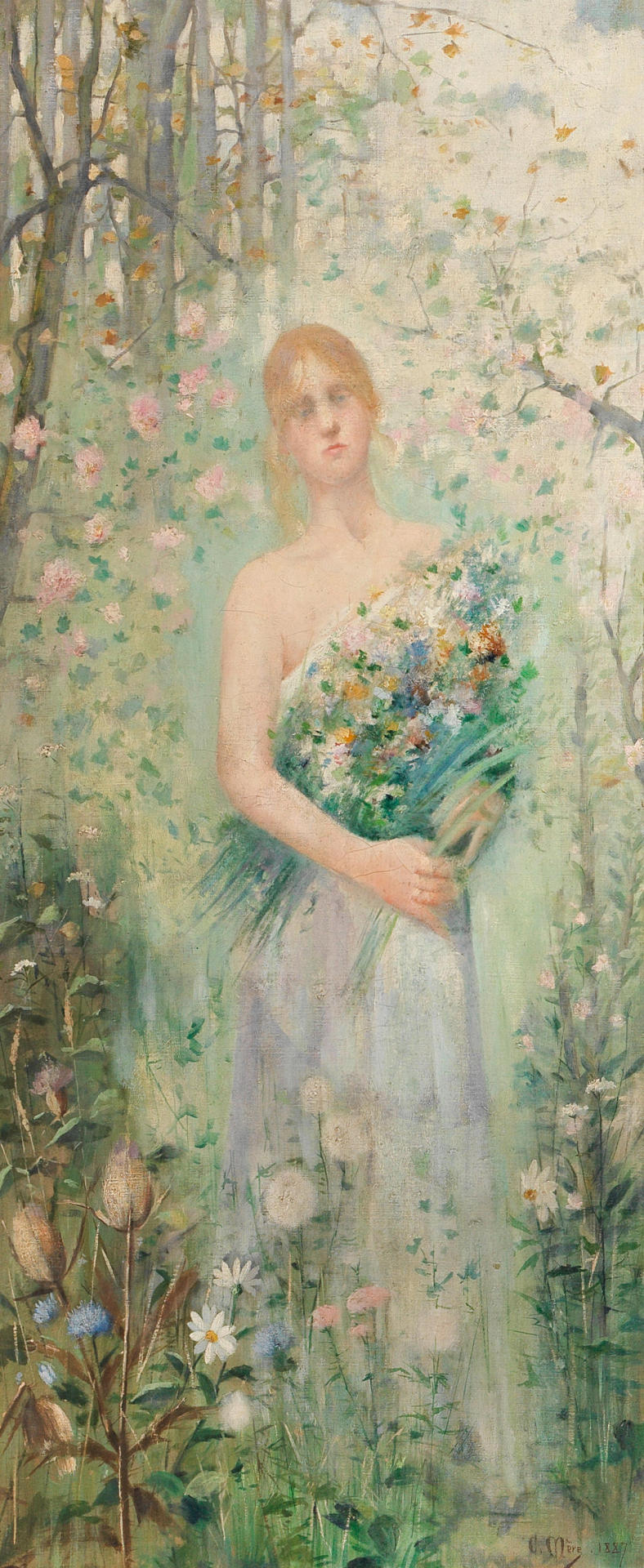
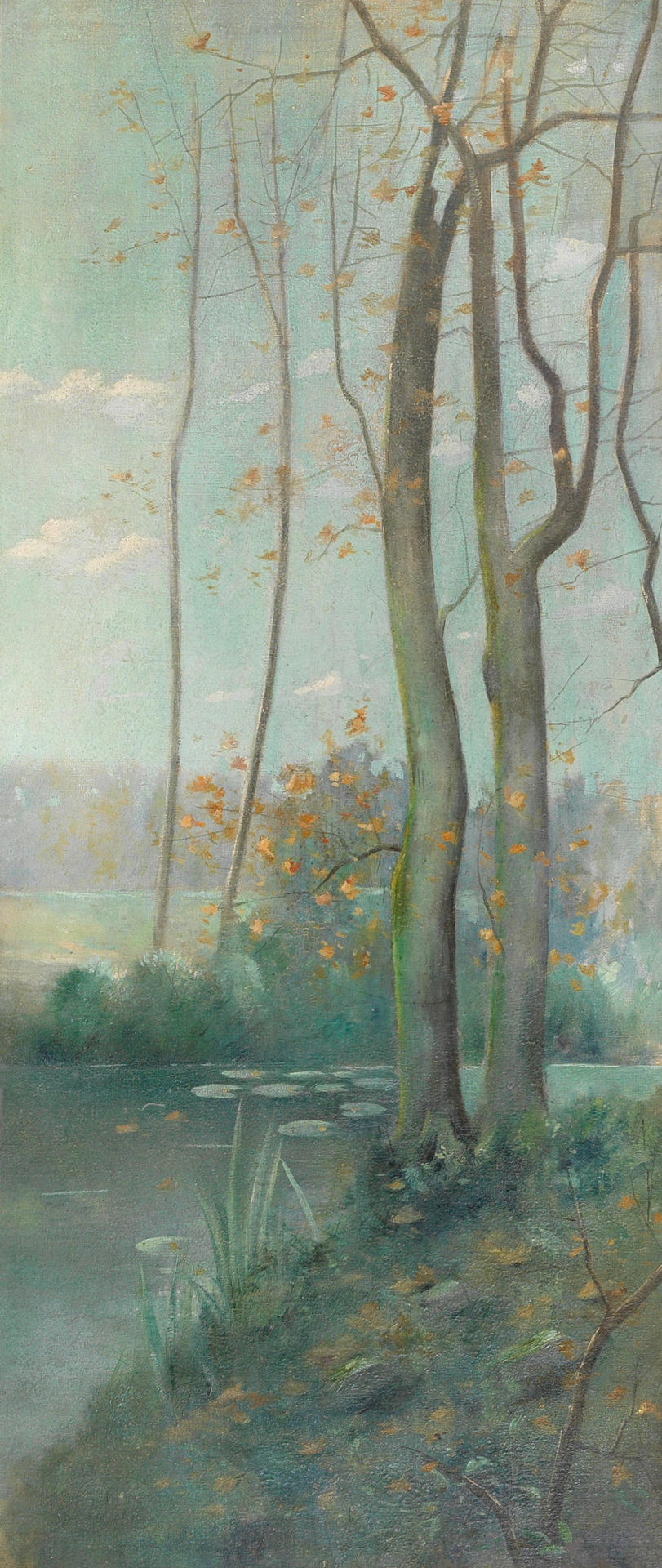

Symbolist triptych, 1887 by Clément Mère
#Clément Mère#symbolism#symbolist art#art#19th century art#art history#decorative art#french art#french painter#painting#oil painting#oil on canvas#triptych#pastel tones
876 notes
·
View notes
Text

Avenue de Clichy, le soir, cinq heures (Avenue de Clichy, evening, five o'clock), Louis Anquetin, March 1887
Pastel on board 23 ¾ x 19 ¾ in. (60.3 x 50.3 cm)
#art#louis anquetin#impressionism#cloisonnism#post impressionism#19th century#19th century art#street scene#1880s#pastel#drawing#french#paris#france
65 notes
·
View notes
Text

A woman pleating her hair (La Cigale)
By Camille Métra
#art#painting#fine art#classical art#french art#french painter#french artist#19th century art#pastel#pastel art#portrait#female portrait#european art#1800s
18 notes
·
View notes
Text

Louise Abbéma (French, 1853-1927)
Sarah Bernhardt à table, c.1885, Musée des Beaux-Arts de la ville de Paris
Pastel
#Louise Abbéma#louise abbema#french#19th century#lesbian artist#lesbian in art#Musée des Beaux-Arts de la ville de Paris#paris#art#pastel#portrait#sarah bernhardt
9 notes
·
View notes
Photo




vin.tagephoto
Paul Helleu
A famous French painter and engraver of the late 19th and early 20th centuries. Paul César Helleu gained fame as a talented artist, primarily due to his elegant portraits of beautiful women of his era. He mastered the drypoint technique and created more than 1,500 beautiful engravings, as well as many oil, pastel and watercolor paintings. The work of the master was strongly influenced by impressionist colleagues.
311 notes
·
View notes
Text

🩰 𝐓𝐡𝐞 𝐂𝐨𝐪𝐮𝐞𝐭𝐭𝐞 𝐀𝐞𝐬𝐭𝐡𝐞𝐭𝐢𝐜 : 𝐈𝐧𝐭𝐫𝐨𝐝𝐮𝐜𝐭𝐢𝐨𝐧
What is the coquette aesthetic ?
The coquette aesthetic is a dreamy, ultra-feminine style that blends innocence with flirtation. Rooted in a nostalgic longing for vintage femininity, it captures the delicate balance of soft beauty and playful allure. Think light, pastel colors-especially pink, and red- alongside pearls, lace, ruffles, and bows. Common motifs include roses, hearts, and vintage l—gerie, reflecting both sweetness and subtle femme fatale energy.
When did the aesthetic originate ?
The term "coquette" originally comes from the French word for "flirt" and was historically used to describe women who exuded charm and light-hearted seduction. While coquettes have been a cultural figure since the 18th and 19th centuries, the aesthetic in today's digital age gained popularity on social media platforms like Tumblr and TikTok, drawing from the styles of icons like Brigitte Bardot and Lana Del Rey. The modern coquette look mixes vintage inspiration from the 1950s and 1960s with a dash of Lo—ta fashion.
How to become a "coquette" (more in-depth in my next post)
The aesthetic embodies romantic femininity but isn't just about looking soft or dainty-it's about embracing confidence, independence, and knowing the power of one's charm. She's elusive, sweet yet seductive, innocent yet a bit daring. Her beauty may seem delicate, but it's calculated in its artfulness.
Caring yourself in a feminine manner is advised. Being kind to others and especially yourself is important. Indulge in self-care whether that be a warm bath or enjoying some chocolate. Keep up with your hygiene ! Shower with scented products and collect light perfumes (post on fragrance coming soon). Of course most of us either go to school or work, but your hobbies should be enjoyable things that calm to brain after using the productive and logical parts of your brain.
next post: a guide to dressing coquette




#pink#coquette#dollette#coquette aesthetic#balletcore#pink pilates princess#waif#girlblogger#vintage#victorian#regency#50s#60s#feminine#femininity#lana del rey#thecoquettehandbook
9 notes
·
View notes
Text

Dans le bleu, Amélie Beaury-Saurel, 1894
#art#art history#Amélie Beaury-Saurel#female artists#portrait#portrait painting#French art#19th century art#pastel#pastel on canvas#Musée des Augustins
356 notes
·
View notes
Text

By Odilon Redon (French, 1840-1916)
"Apparition"
#odilon redon#Art#Artist#Art history#Artwork#History#Painting#Painter#Oil painting#Pastel#Symbolist#Symbolism#Symbolist art#Symbolist painting#19th century#19th century art#museum#Classical art#traditional art#figurative#illustration#art detail#texture#traditional painting#fine art#1800s art#dreamy#mythical#french art#classic painting
804 notes
·
View notes
Text
Hello friends. Would you like to meet the antagonist of Faust's route? The dastardly entity responsible for untold pain and misery, for putting our intrepid couple through the metaphorical wringer? The arch-enemy of mankind for centuries??
(spoilers behind the cut)

Here you go! Yersinia pestis, or Y. pestis to its friends, in all its gram-negative, electron scanned, color enhanced glory.
Aww, but Mrs O, you say, it's so cute! Look at its widdle fimbriae waving hewwo! Its pastel pink Lisa Frank inspired palette!
But don't be fooled! This tiny cold-blooded killer is responsible for more deaths than possibly any other infectious agent in the history of humankind - we all know it as the bubonic plague. The Black Death. It's cut down hundreds of millions of people over the course of human history, and it is still a threat today.
Transmitted to humans primarily by the bite of fleas, Y. pestis is a nasty character - without treatment, mortality rates upon infection are 30% - 90%. It sets up shop in a nearby lymph node, gets busy, and the resulting damage causes tissues to die. Victims tend to develop large, swollen, and painful lymph nodes called buboes, which is where the illness gets the name 'bubonic plague'.
One thing to note though, for Faust's route, is that while we generally think of this type of plague as THE plague...there are two other forms an infection with Y. pestis can take. A septicemic infection, where the bacteria enter the blood stream rather than the lymph nodes and which is almost always fatal, and a pneumonic version. This one here is the stuff of epidemiology nightmares. It often is the result of inhaling airborne droplets from another infected individual, and it can spread from person to person very easily unlike the usual bubonic form which requires bodily contact or a bite from an infected flea. It causes fevers, weakness, and violently severe coughing, and without antibiotics is nearly 100% fatal in a frighteningly short period of time - most victims are dead within mere days. Sometimes hours.
The first major recorded outbreak of the bubonic plague was the Plague of Justinian, which began about 1,500 years ago in 541 CE and ravaged the Sasanian and Byzantine empires. It's estimated that the plague resulted in anywhere from 15 to 100 million deaths, up to 40% of the population of Constantinople at the time, and some historians believe people were dying at a rate of 5,000 per day in the capital city.
The second plague epidemic, the one many people are more familiar with, was the one we refer to as the Black Death. This epidemic began raging across Europe, the Middle East, North Africa, and Asia in the late 1330s, with Europe being hit particularly hard. By the time it was over Europe would see its population cut between 30% and 60%, and the Middle East losing about a third of its people as well. Numbers are difficult to estimate but they range from 75 -200 million dead.
There is, however, a third plague epidemic, although not as well known. In the 18th century the plague made a resurgence in SW China, remaining somewhat localized until the mid 19th century when it spread to Hong Kong and from there globally. There were outbreaks in the United States, India, many African countries, SE Asian countries, Russia, South America, the Caribbean, and most importantly for our story purposes - Europe. The largest outbreak was in Lisbon, but there were many smaller pockets of infection in various cities across the continent.
This was around the time the plague bacterium got its scientific name, Yersinia pestis, because of this man - a secondary character in our vampire love story, albeit with a slightly different name:
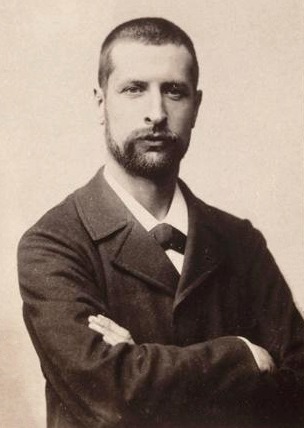
Say hello to Alexandre Yersin, a Swiss-French doctor and scientist.
Keenly interested in bacteriology, in 1886 he studied in Paris where Louis Pasteur was doing work in microbiology and worked on antiserum for rabies and antitoxin for diphtheria, two other famous scourges. (Antiserum, in the briefest of explanations, is basically a way to transfer antibodies from someone/something exposed to an infectious agent to a different person, thereby triggering the recipients immune system earlier and more vigorously EDITED TO ADD: this also applies to venom and this is actually how antivenom is made as well!)
In 1894, he was sent to Hong Kong to investigate the plague outbreak and it was here that he identified the bacteria responsible, the one that now bears his name, along with confirmation of its transmission route via rodents. (A Japanese scientist in Hong Kong at the same time, Kitasato Shibasaburou, independently identified the bacterium almost simultaneously as well, but because his documentations were not as clear it is Yersin who is generally credited with the initial find)
Yersin spent the next few years continuing his studies of the plague, traveling back to Paris in 1895 to develop the first anti-plague serum. It was the work of scientists like him, and so many others at this time, that paved the way for modern medicine and a path towards eradicating the diseases that have held us in their skeletal grip for so much of mankind's history.
...And perhaps, in the world of Ikevamp, that path owes just a little bit to a certain bespectacled German priest.
#ikemen vampire#ikevamp#ikevamp faust#spoiler#spoilers#ikemen vampire spoilers#ikevamp spoilers#how to tag this?#lore? background? idek#maybe just 'stuff i wish i'd known the first time i read his route'
78 notes
·
View notes
Text
Lecture Notes MON 16th OCT
Masterlist
BUY ME A COFFEE
Doing Art History: Drawing/Works on paper.
Oeuvre: the artworld of that time. The body of work by a painter, composer, or author.
Drawing was and has always been the first step into becoming an artist, it is the most fundamental and important aspect of any artistic study or development. To know your fundamentals, the figure, perspective, and weight/shading. Historically this is the first step any artist took, before developing into their preferred medium.
Observe these drawings/sketches and paintings; consider the materials, their effect and product.



Jean-Auguste-Dominique Ingres, Vicomtesse Othenin d'Haussonville, nee Louise Albertine de Broglie, study, ca. 1845, graphite, with white heightening, on paper, France, Musée de Carpentras.
Colourism – (not to be confused with the discrimination based on skin colour) Specifically in painting, it is a style of painting characterised by the use of intense colour, which becomes the dominant feature of the resultant work of art, mostly influential in the French impressionism movement of the 19th century.
Also: a person who uses colour in s particular way, draws attention to the colour use.

HILAIRE-GERMAIN-EDGAR DEGAS, WOMAN STANDING IN A BATHTUB C. 1890–92, charcoal with stumping on beige wove paper, 43.2 x 29.5 cm, Sterling and Francine Clark Institute

Edgar Degas After the Bath, Woman Drying Herself, c. 1890-95 Pastel on wove paper laid on millboard. 103.5 x 98.5 cm. The National Gallery, London. Bought, 1959. Photo: © The National Gallery, London
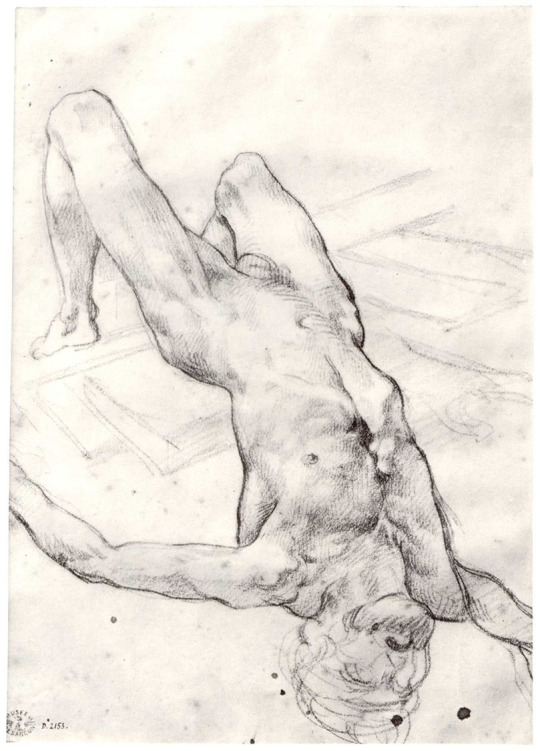
Théodore Géricault, Study for the Raft of Medusa, 1818, charcoal on paper, Paris, Musée du Louvre.
Observe the contour line (the darker outline line), surrounding the body. Note the twist and strain of the muscles and exaggeration of line and pose to create drama on the paper. Also note the materials used. Charcoal: a material that possesses a short life on paper without additives to preserve it. Something that smudges easily. Perhaps to quickly capture the body and idea and shading.
The Male nude – which surprisingly are the most common nude that exists in the western world. And this is because the basic fundaments were learnt from drawing casts, from the ancient world, or drawing from other works of art. Sketching development and a skill development, meant drawing bodies and getting to access to more complex forms to keep learning.
The RA is doing an exhibition on Impressionist on paper, which from the photos of artworks in this post, I recommend going to and seeing and judging for yourself, the use of materials and their effects.
On Degas and pastels: you can over saturate paper with pastels, muddying the colour. Critics of Degas spoke out, how his portrayal of bodies appear bruised. Degas was less interested in accuracy, more into the exploration of light on the body, the illumination, and the space it inhabits.
Genres of painting: Landscape, Portrait, Still life, Genre, Historical, Allegorical:
Allegorical paintings covered mythos. These were most prominent and popular when the state collected paintings, rather than when commissions came into prominence, and private ownership of painting rose.
Impasto: when paint stands off from the canvas. An Italian word for “mixture,” used to describe a painting technique wherein paint is thickly laid on a surface, so that brushstrokes or palette knife marks are visible. A pastose surface is one that is thickly painted.
19th century: paints in tubes begin to make an appearance.
Plain air: painting outside, open air painting. A common impressionist's expression.

Claude Monet Cliffs at Etretat: The Needle Rock and Porte d’Aval, Pastel on wove paper, c. 1885. 39 x 23 cm. National Galleries of Scotland. Accepted in lieu of Inheritance Tax by H M Government from the estate of Miss Valerie Middleton and allocated to the Scottish National Gallery, 2016
Drawings always have a subjective idea of being ‘finished’ surrounding them. A rising problem surrounding the impressionist artists was critics perceptions of the artworks seeming unfinished, which could decrease a value of an artwork.

Berthe Morisot, At the Beach in Nice, 1882, pencil and watercolour, Stockholm, Nationalmuseum.
Note the signing of this particular artwork, in the bottom left corner. A tendency that arose after an artist died and their work became more famous or popular, their families would sign the work in their name.
Moreover, looking at this artwork it may surprise some to know that watercolour is considered a less prestigious material to use. As opposed to oil painting, which carries a greater prestige due to its difficulty to use and master. Leaving less room for imperfections. As a snide response to the impressionist movement, critics suggested that these artist under this movement, stick to and use watercolour.
Consider critics opinions of materials and how that translates to accessibility and intension.
Watercolour is actual a far more accessible material than oil painting and can give you a great finish, especially for artists that were painting on open air and their surroundings live.
#art#artwork#writing#essay#paintings#art tag#art hitory#art exhibition#art show#art gallery#lecture#essay writing#writers#creative writing#writeblr#writers on tumblr#writers and poets#education#learn#teaching#learning#students#educators#artists#artists on tumblr#drawings#illustration#art style#history#histoire
9 notes
·
View notes
Text
Virtual Sketchbook #3
Portrait of Madame de Bourbon-Conti as Venus
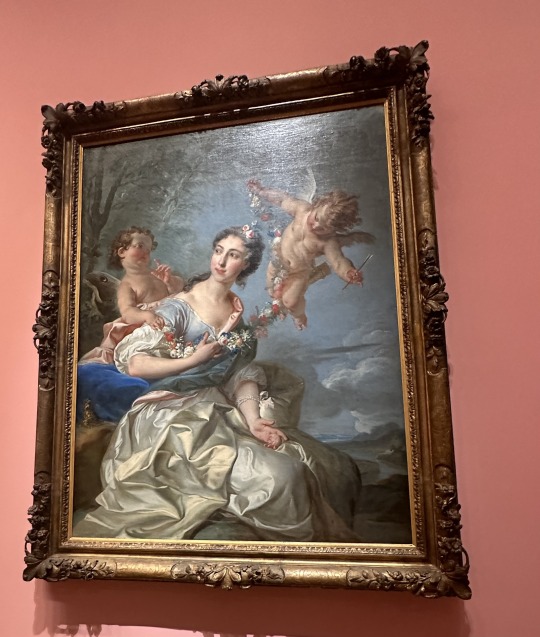
Picture: Taken from iPhone by Ashley Vasquez on 03/28/2024 at the Ringling Museum
The painting Portrait of Madame de Bourbon-Conti as Venus, made byNoel-Nicolas Coypel, is an oil on canvas that is 54.3 by 42 inches big and currently featured at the Ringling Museum of Arts. Coypel’s painting is a portrait of Elisabeth de Bourbon, Princess of Conti, who was quite beautiful and a subject of much attraction, as clearly depicted. The painting has the allure of a bright dream-like outside scenery alongside flowers and flowing silks that quickly catch people’s attention. There is a trend of light pastel colors such as light pink and white garments, a baby blue sky, and pale colors that highlight the pampered life of French court. Baby cupids also adorn Princess Elisabeth with pretty flowers, which remind the audience of her youth and charismatic charm. Coypel and Elisabeth clearly worked on creating her public image to feature this delicacy and goddess of love illusion through the balance of colors, dimensions, and rococo fragility. Being a fan of the Rococo style drew me into this painting, and while deeply inspecting it, I was reminded of feelings of love, attraction, and even womanhood because of the delicacy and love illusion imbedded within the oils, which I believe is exactly what Elisabeth and Coypel intended the audience to feel.
The Portrait of Madame de Bourbon-Conti is associated with the Rococo art style and was painted during the Enlightenment (18th century). Although the Enlightenments focused on scientific learning and philosophical ideas of life, liberty, and separation of church and power, there was a popular appeal with elite members communicating their wealth through rococo- styled art, interior design, architecture, and more (2.1 Shifting Sensibilities: The Enlightenment and Rococo, ART 188). Princess Elisabeth, being an enlightenment follower herself, illustrated this dramatic shift from the previous baroque style into the lively rococo style when depicting herself. She and Coypel worked on illustrating her image far away from the remote, aloof, and formal style into this delicacy, lighthearted elegance conveyed through light and pastel colors (portrait of Madame de Bourbon-Conti). Understanding the imagery and alluring beauty of this painting tells the audience that Coypel enjoyed painting natural beauty and depicting love and its allure through lightness and asymmetrical pose. Ringling described it as “This Rococo pose reminds us of the change and fragility that love encounters” (portrait of Madame de Bourbon-Conti). The message of great shift and nature beauty found with youth and bright accent is illustrated throughout the painting for the audience to see, as is the image of Elisabeth as a playful and charming goddess. There are also references to how the elite's pampered life and wealth through luscious silks and pearls. There are many references and illustrations to convey the message clearly.
Overall, I think the importance of this art is to bring a different perspective to a changing society. I think it creates this idealized perspective of wealth, love, and beauty. There is something about its specific naturalistic complexity, such as the princesses’ beauty compared to previous works of art, that makes it attractive; however, there’s also referenced to love with baby cupids and imaginary figures. I believe this painting was made to catch the audience’s attention to this dream-like scenery and entice us with beauty while reminding us of love. As a woman, I particularly felt drawn to its beauty.
Sources used:
2.1 Shifting Sensibilities: The Enlightenment and Rococo – ART 188. art188.lib.miamioh.edu/18th-and-19th-century-art/1-enlightenment-and-rococo.
PORTRAIT OF MADAME DE BOURBON-CONTI. ringlingdocents.org/pages/bourbon-conti.htm.
Ringling Photos:
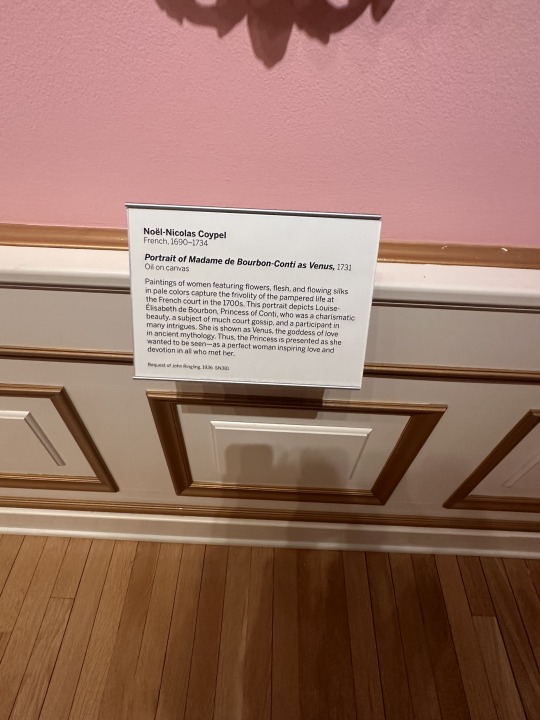

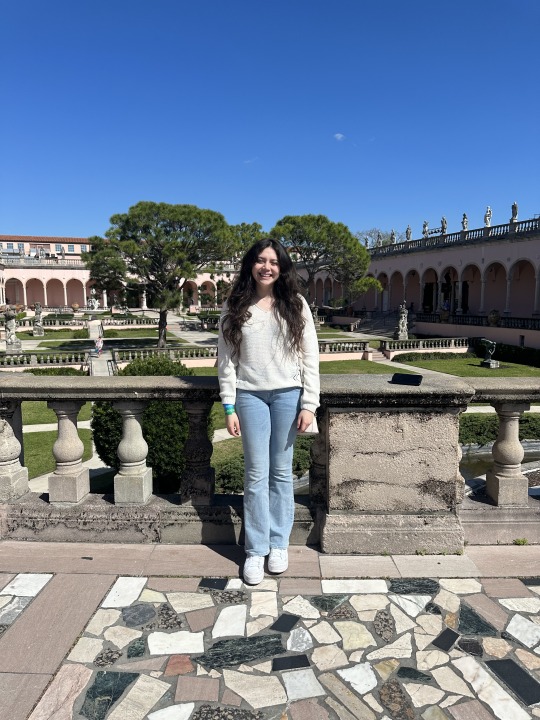
2 notes
·
View notes